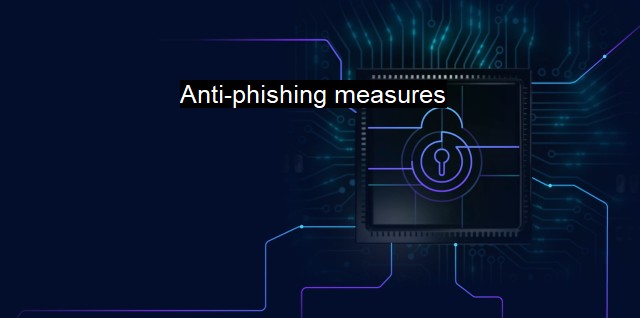What are Anti-phishing measures?
Combatting Phishing Attacks in the Digital Landscape: Understanding the Importance of Anti-Phishing Measures and Antivirus Systems for Organizations
Anti-phishing measures are methods and strategies used to counteract and prevent phishing, a significant online threat considered to be one of the most harmful types of cyber-attacks. Phishing schemes typically involve tricking targets into revealing sensitive or private information, such as personal, financial, or business details. These scam attacks usually come in the guise of a trustworthy entity to bait unsuspecting individuals to open a malicious link, consequently providing the hackers unfettered access to one's system and confidential data.In terms of cybersecurity and antivirus, the concept of anti-phishing measures is essential in safeguarding individual or organizational information systems from phishing attacks. These measures are integral components of a fully functional security infrastructure that ensures that networks, systems, and data are protected from unauthorized access or damage.
One commonly used anti-phishing measure involves training and education programs. As people are often the weak points in any security chain, they are the main targets of phishing attacks. Consequently, providing them with appropriate training on recognizing phishing tricks and securing their information becomes a vital defense mechanism. An informed, educated user is far less likely to fall victim to phishing ruses.
Also crucial are anti-phishing software systems. These programs are designed to scan emails and websites for phishing indicators, subsequently blocking these potentially harmful sites or messages. Some of these applications can even inhibit users from inadvertently entering personal information on suspicious or unencrypted websites. They typically offer real-time protection against phishing threats, identifying them as they emerge, allowing for immediate response to mitigate potential damage. Anti-phishing software programs form part of a larger category of security software known as anti-malware or antivirus software.
Technologies that identify and counteract phishing emails also play a crucial role in phishing prevention. Email filtering tools, for instance, can recognize emails from known phishing entities and redirect them to spam or junk folders, thus limiting their probability of reaching a user’s inbox. Similarly, email authentication technology prevents phishing by examining if the sent email is legitimately from the displayed sender, dramatically reducing fraudulent email deliverability.
Secure networks also serve as anti-phishing measures, particularly secure gateways that defend against threats coming from the internet. These gateways examine all incoming and outgoing network traffic for potential threats and block them. This technology incorporates tools that counteract phishing, such as DNS filtering that prevents users from accessing known phishing sites. firewalls serve as a distinguishing line between secure internal networks and potentially unsafe internet resources. They essentially contribute to blocking phishing attempts in the initial stages.
Frequent software and system updates are fundamental measures in combating phishing. Evidently, attackers often exploit known vulnerabilities in outdated or unpatched systems. Therefore, making sure that software, apps, and systems are up-to-date is especially crucial for cybersecurity hygiene and preventing phishing attacks.
A multi-factor authentication process is another anti-phishing measure to consider. It can add an extra layer of security by requesting several pieces of confidential information before granting access. Even if a phishing scam does culminate in attackers acquiring a user’s password, they would be unable to access the account without the other authentication factors.
Organizations and individuals need to invest in robust defences that are designed, planned, and executed to consider human needs and behaviors because even the most educated individuals can sometimes fall prey to well-executed schemes. As antivirus and cybersecurity technologies continue to advance, it’s clear that the battle against phishing needs a combination of mitigation measures, vigilance, awareness, education, and modern technology to successfully protect systems and data while ensuring that organizations run securely and effectively.

Anti-phishing measures FAQs
What are anti-phishing measures?
Anti-phishing measures are actions or strategies taken to protect individuals or organizations from falling victim to phishing attacks. These measures are designed to prevent malicious actors from stealing sensitive information by posing as a trustworthy entity.What are some common anti-phishing measures?
Some common anti-phishing measures include installing antivirus software, using two-factor authentication, regularly updating passwords, and avoiding clicking on suspicious links or downloading attachments from unknown sources. Additionally, organizations can train their employees on how to recognize and avoid phishing attempts.How effective are anti-phishing measures?
Anti-phishing measures can be very effective if implemented and used correctly. However, it's important to note that no measure is foolproof, and attackers are constantly adapting their tactics to find new ways to bypass security measures. That's why it's important to continually update and improve anti-phishing measures to stay ahead of attackers.Are anti-phishing measures only necessary for businesses?
No, anti-phishing measures are important for individuals as well. Anyone who uses email or the internet can be targeted by a phishing attack, and the consequences can be serious, such as identity theft or financial loss. Individuals can protect themselves by following best practices, such as avoiding clicking on suspicious links and regularly updating passwords.| | A | | | B | | | C | | | D | | | E | | | F | | | G | | | H | | | I | | | J | | | K | | | L | | | M | |
| | N | | | O | | | P | | | Q | | | R | | | S | | | T | | | U | | | V | | | W | | | X | | | Y | | | Z | |
| | 1 | | | 2 | | | 3 | | | 4 | | | 7 | | | 8 | | |||||||